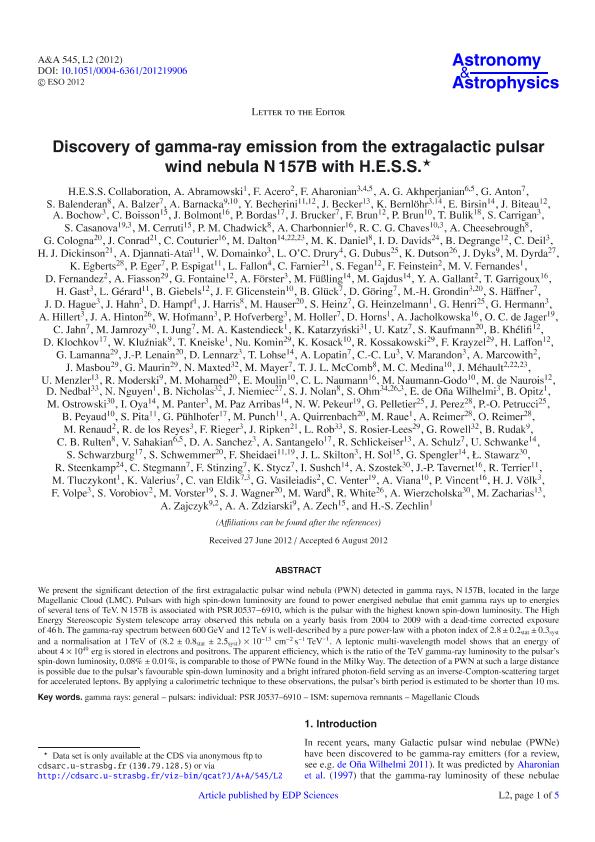Artículo
Discovery of gamma-ray emission from the extragalactic pulsar wind nebula N 157B with H.E.S.S.
Abramowski, A.; Acero, F.; Aharonian, Felix A.; Akhperjanian, A. G.; Anton, G.; Medina, Maria Clementina ; Spengler, G.; Stawarz, Ł.; Steenkamp, R.; Stegmann, C.; Stinzing, F.; Stycz, K.; Sushch, I.; Szostek, A.; Tavernet, J.-P.; Terrier, R.; Tluczykont, M.; Valerius, K.; van Eldik, C.; Vasileiadis, G.; Venter, C.; Viana, A.; Vincent, P.; Völk, H. J.; Volpe, F.; Vorobiov, S.; Vorster, M.; Wagner, S. J.; Ward, M.; White, R.; Wierzcholska, A.; Zacharias, M.; Zajczyk, A.; Zdziarski, A.; Zech, A.; Zechlin, H.-S.; H.E.S.S. Collaboration
; Spengler, G.; Stawarz, Ł.; Steenkamp, R.; Stegmann, C.; Stinzing, F.; Stycz, K.; Sushch, I.; Szostek, A.; Tavernet, J.-P.; Terrier, R.; Tluczykont, M.; Valerius, K.; van Eldik, C.; Vasileiadis, G.; Venter, C.; Viana, A.; Vincent, P.; Völk, H. J.; Volpe, F.; Vorobiov, S.; Vorster, M.; Wagner, S. J.; Ward, M.; White, R.; Wierzcholska, A.; Zacharias, M.; Zajczyk, A.; Zdziarski, A.; Zech, A.; Zechlin, H.-S.; H.E.S.S. Collaboration
 ; Spengler, G.; Stawarz, Ł.; Steenkamp, R.; Stegmann, C.; Stinzing, F.; Stycz, K.; Sushch, I.; Szostek, A.; Tavernet, J.-P.; Terrier, R.; Tluczykont, M.; Valerius, K.; van Eldik, C.; Vasileiadis, G.; Venter, C.; Viana, A.; Vincent, P.; Völk, H. J.; Volpe, F.; Vorobiov, S.; Vorster, M.; Wagner, S. J.; Ward, M.; White, R.; Wierzcholska, A.; Zacharias, M.; Zajczyk, A.; Zdziarski, A.; Zech, A.; Zechlin, H.-S.; H.E.S.S. Collaboration
; Spengler, G.; Stawarz, Ł.; Steenkamp, R.; Stegmann, C.; Stinzing, F.; Stycz, K.; Sushch, I.; Szostek, A.; Tavernet, J.-P.; Terrier, R.; Tluczykont, M.; Valerius, K.; van Eldik, C.; Vasileiadis, G.; Venter, C.; Viana, A.; Vincent, P.; Völk, H. J.; Volpe, F.; Vorobiov, S.; Vorster, M.; Wagner, S. J.; Ward, M.; White, R.; Wierzcholska, A.; Zacharias, M.; Zajczyk, A.; Zdziarski, A.; Zech, A.; Zechlin, H.-S.; H.E.S.S. Collaboration
Fecha de publicación:
08/2012
Editorial:
EDP Sciences
Revista:
Astronomy and Astrophysics
ISSN:
0004-6361
Idioma:
Inglés
Tipo de recurso:
Artículo publicado
Clasificación temática:
Resumen
We present the significant detection of the first extragalactic pulsar wind nebula (PWN) detected in gamma rays, N 157B, located in the large" "Magellanic Cloud (LMC). Pulsars with high spin-down luminosity are found to power energised nebulae that emit gamma rays up to energies of several tens of TeV. N 157B is associated with PSR J0537−6910, which is the pulsar with the highest known spin-down luminosity. The High Energy Stereoscopic System telescope array observed this nebula on a yearly basis from 2004 to 2009 with a dead-time corrected exposure of 46 h. The gamma-ray spectrum between 600 GeV and 12 TeV is well-described by a pure power-law with a photon index of 2.8 ± 0.2stat ± 0.3syst" "and a normalisation at 1 TeV of (8.2 ± 0.8stat ± 2.5syst ) × 10−13 cm^{−2} s^{−1} TeV^{−1} . A leptonic multi-wavelength model shows that an energy of about 4 × 1049 erg is stored in electrons and positrons. The apparent efficiency, which is the ratio of the TeV gamma-ray luminosity to the pulsar?s spin-down luminosity, 0.08% ± 0.01%, is comparable to those of PWNe found in the Milky Way. The detection of a PWN at such a large distance is possible due to the pulsar?s favourable spin-down luminosity and a bright infrared photon-field serving as an inverse-Compton-scattering target for accelerated leptons. By applying a calorimetric technique to these observations, the pulsar?s birth period is estimated to be shorter than 10 ms.
Archivos asociados
Licencia
Identificadores
Colecciones
Articulos(IAR)
Articulos de INST.ARG.DE RADIOASTRONOMIA (I)
Articulos de INST.ARG.DE RADIOASTRONOMIA (I)
Citación
Abramowski, A.; Acero, F.; Aharonian, Felix A. ; Akhperjanian, A. G.; Anton, G.; et al.; Discovery of gamma-ray emission from the extragalactic pulsar wind nebula N 157B with H.E.S.S.; EDP Sciences; Astronomy and Astrophysics; 8-2012; 2-7
Compartir
Altmétricas



